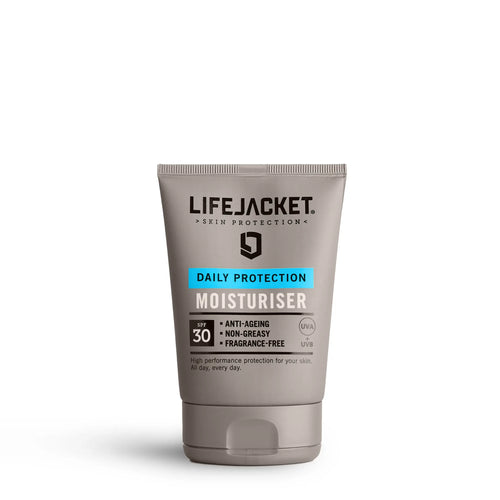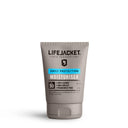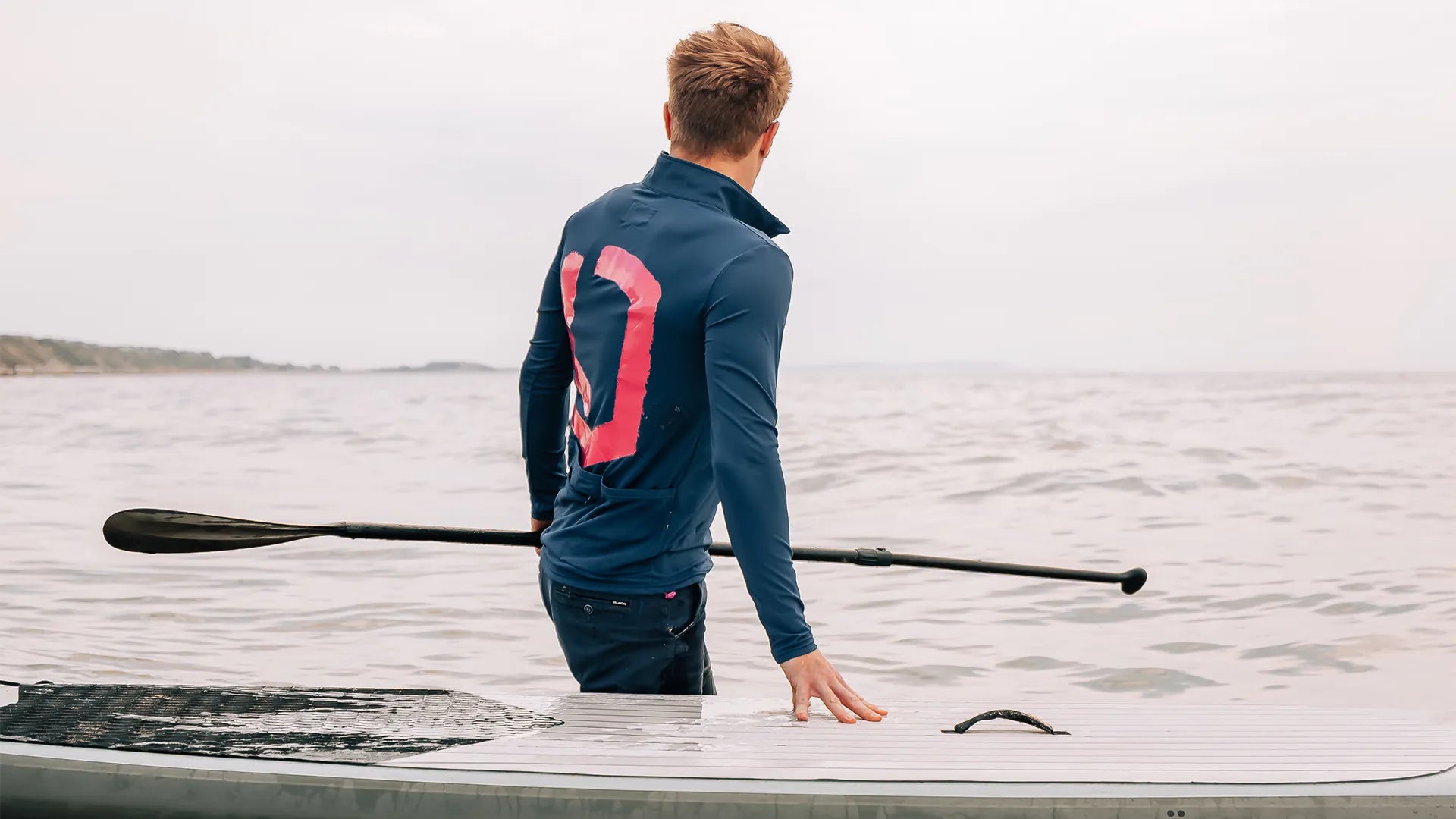Recently, I was with a group of guys for a few days who I hadn't met before. A good friend called Matt invited me away on a long weekend with a small group of his close friends. It was a bit of a music pilgrimage to hear see some DJs and give us all a brief taste of summer.
We all got to know each other and after 24 hours of being together, somebody asked me if LifeJacket had changed my behaviour in the sun. He noticed me get out of the sea and put a top on straight away. At the time, I was the only person sitting in the sun with a long-sleeved top on. That got me thinking...
So, what's changed?
The truth is I do now practice what I live by.
And that's a complete U-turn compared to what I did in my twenties. I used to love being tanned and did whatever I could to be in the sun.
Now, I use our SPF 30 Daily Protection Moisturiser religiously after showering every single morning, all year round. In the summer months, I actually use the SPF 50+ Sun Gel instead.
When directly in the sun, I'm more focused on shade than sun and religiously apply sunscreen to exposed skin. I've also been known to wear a hat despite having thick hair.
And as my new friend observed, I actually prefer to wear clothing when possible (or practical), to provide a physical barrier for my skin.
Now, I'll be honest with you...
For me, my change in approach is probably driven by vanity first and health second. We know that 90% of ageing, wrinkles and lines are caused by ultraviolet light. In the back of my mind and at the same time, I also know I'm doing all I can to help reduce the risk of getting skin cancer.
Is clothing overkill?
One of the most surprising facts we discovered is that a standard, white cotton t-shirt provides the equivalent protection to an SPF 5 sunscreen.
If the sun was strong on a given day, your skin could burn through that particular t-shirt. And if the t-shirt gets wet, the protection level drops even lower. All of this is according to The Skin Cancer Foundation.
The reason for that is because fabrics are made of tiny fibres that are woven or knitted together in a grid. Under a microscope, we can see spaces between the fibres through which ultraviolet radiation (UV) can pass and reach the skin. The tighter the knit or weave, the smaller the holes and the less UV can get through. Denim for example is a heavy and tightly woven fabric. Jeans have a UPF rating of 1700 but they're not so practical in 30-degree heat. Open weave fabrics like linen provide much lower protection.
An agency in Australia spotted this in the late 90s and standardised the concept. They created a measure for clothing or fabrics and called it the Ultraviolet Protection Factor (UPF). This is a measure of how much UV can pass through a fabric.
To be clear, all fabrics and clothing will have a UPF measure of some kind. But to claim that an item of clothing offers UV protection, the fabric must be tested in a laboratory to provide absolute confidence and safety to consumers.
What does UPF mean?
More numbers and abbreviations in the world of sun protection is not what people need but here we are.
Essentially, UPF is to fabrics what SPF is to lotions/liquids/creams. It's a measure of how effectively the fabric protects your skin from UV. In the case of UPF, the measurement quantifies how effectively a piece of clothing shields your skin from the sun's rays, depending on factors such as the fabric’s content, weight, colour, and construction.
There's an ever so subtle difference between SPF and UPF. SPF measures how effective a sunscreen is at blocking UVB rays only. For sunscreens, there is a separate measure for UVA. UPF measures how effective a fabric is at blocking both UVA and UVB - so in that respect, it's more holistic.
So putting words to one side, here are the numbers:
- A UPF 5 t-shirt allows 1/5th (20%) of the sun's UVA and UVB rays to reach the skin.
- A UPF50+ shirt allows 1/50th (2.0%) of the sun’s UVA and UVB rays to reach the skin
- Another way to think about it is if 50 units of UV hit the fabric, only one would pass through
We know that UV is responsible for 90% of melanomas so reducing exposure can make a difference.
Why bother with UPF as well as SPF?
I actually think clothing is the ultimate in sun protection because it provides a physical barrier.
There are times when I can't be bothered to apply sunscreen, I don't want to or it isn't practical.
If I know I'm going to be outside in the sun for a long period of time, such as a long walk, hike, climb, day on the beach or sitting on a boat, I turn to sun protective clothing. How easy is it just to throw on a t-shirt after all?
There's also a smaller chance of getting things wrong. When it comes to sunscreen, it's very common to use too little and burn. Or it might just come off as you towel, sweat or swim. You don't have that problem with UPF fabric. Once it's on, you're good.
Is UPF clothing all rash vests and wet suits?
I don't want to mislead you and tell you that UPF clothing is readily and cheaply available in a range of styles, cuts and colours. It isn't. However, it has evolved from the thick rash vests of old.
Although the uptake is slow, brands like Under Armour, Nike, Patagonia and Lululemon produce the odd UPF item. There are also UPF-specific clothing companies around.
And then (of course) there's the LifeJacket range of UV protective clothing with our characteristic branding. Why would I miss the opportunity for a plug?
We spent years sourcing and testing fabrics so that we comply with European standards and can proudly label our clothing range as UV protective wear.
Many fabrics in this world are treated with chemicals to block the sun. This treatment wears out after a certain number of washes. Our fabrics, by contrast, are UPF 50+ thanks to the technology of the weave and the specific threads we use. They will always protect you regardless of what you do to them. All our fabrics (in all colours and styles) have been tested in laboratories so you can be confident they offer the maximum UPF 50+ rating.
The t-shirts are light, moisture wicking and extremely comfortable. I live in them when I'm outdoors, on the beach, by the pool, at lunch or when exercising outside.
Sales pitch over. But they’re great. Really.
Conclusion
For the sake of convenience, vanity and health, I think sun protective and UPF clothing is actually quite an interesting and viable option for time outside. I prefer it to skincare but that's a personal thing. If you can find styles you like and that don't make you too hot, it might be worth considering. Just make sure you look out for the UPF symbol and get something that has a high level of protection. It's all very well covering up with other fabrics but if the sun goes right through them, they're not much use to you.








